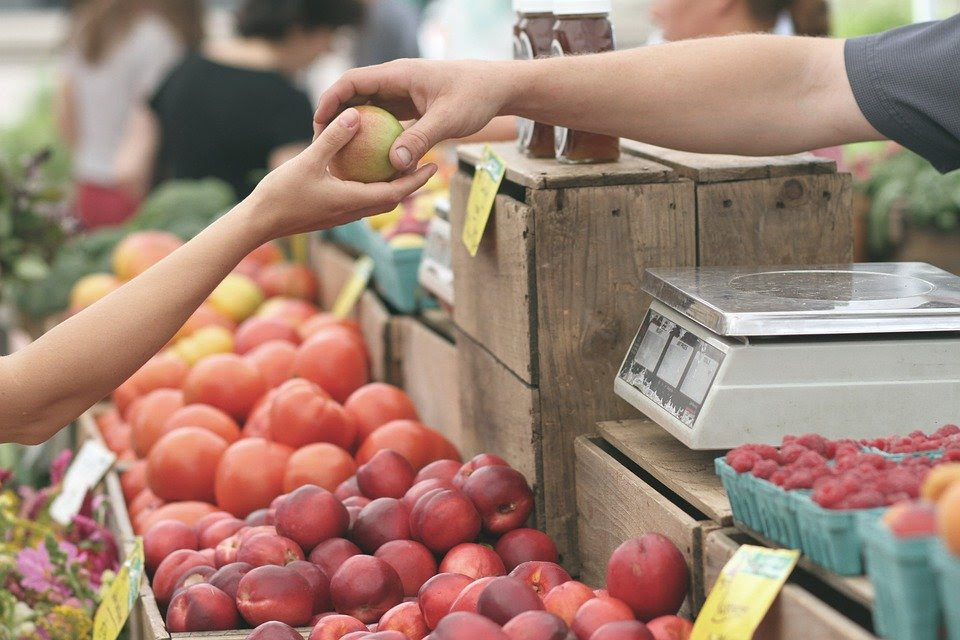
The vendors’ stands in any one of Peterborough’s farmers’ markets right now are amazing. The vegetables, fruits, baking, meats, cheeses, honey, jams, and other prepared foods make your head spin as you imagine how it all might taste. How lucky we are to have such abundance on our doorstep.
If you go regularly to these markets the vendors become your friends. You learn about their families and their challenges. But best of all you reap the delicious rewards of their successes. In the end what is purchased in the market is much more than basic staples. It is much more than a commodity. Each transaction symbolizes a shared view of the world between you and local producer. What you buy fills your belly, but it really nourishes your soul. To some it becomes something sacred.
But what does it really take to have such richness on our doorstep? And how do we ensure that everyone can afford to shop at these markets? And make sure that what is sold in the markets is what the diverse population of Peterborough wants to eat? How do we guarantee access to the land, the sea, the rivers, the lakes, the seeds, the forests, the tools, the time, the markets to be able to hunt, trap, cultivate or simply purchase what we all understand as ‘good’ food, as ‘our’ food? These questions capture the essence of food sovereignty.
We all have food we would call ‘our’ food. The food we love; the food we crave. To Indigenous people in this country, the taste of raw seal meat, eulachon oil, cedar-smoked salmon, fry bread, manomin or wild rice, dried eel, or succotash—were central to traditional diets. These foods were strange and at times unpalatable to long ago colonizers who longed for pots of mutton or venison stew, bread, cheese, and the indulgent sweetness of the cakes they knew in England or France. Those who came here as more recent immigrants from around the globe have brought to us new and tantalizing tastes, the tastes they knew at home. What would it take for these foods to be seen as local food? To be readily available here, in Peterborough?
As children we learned to treasure the tastes of ‘our’ food’. It was food made with care by someone who cared about us. It was the scrumptious tastes of food eaten only on festive days and celebrations. It is the food that truly satisfies hunger. The food we eat reflects who we are. Such comfort food resonates at a deep psychological, emotional, and cultural level. And for some also at a spiritual level as religious beliefs dictate what is or is not good to eat. Food sovereignty means allowing people to have access to the kinds of food they desire, they need, the food they know as ‘good food’.
Food sovereignty is something different from food security. Simply put, food security means having enough to eat every day to satisfy nutritional needs. According to the UN, being food secure is a basic human right. What would it take for food sovereignty to be understood in the same way? This question has become central to the many initiatives to overcome hunger, poverty, and improve global health.
Food sovereignty privileges the social, cultural, and political dimensions of food and food systems in a community. It shifts the focus to the local, and to ecologically sustainable and resilient practices that ensure producers can control:
- what foods they produce or harvest
- how they produce or harvest them
- where they grow or harvest this food
- who they are producing/harvesting this food for
Food sovereignty challenges industrialized monoculture agriculture and its central focus on impersonal global markets. It targets the environmental destruction such practices have inflicted upon our planet. It speaks directly to the rising threat of climate change. It also asks how we ensure that international trade agreements never threaten the capacity of a ‘nation’—however it is defined—to feed itself?
In Canada, food sovereignty can have transformative capacity. It can support rural communities. It can help stop the exodus of those who called ‘the farm’ home by improving incomes for them. It can support new young farmers moving in who are committed to learning sustainable practices. It can ensure healthier foods at affordable prices. It can help all of us to see our land and water restored and protected. It can also expand what we all understand as ‘good food’.
There are several pillars at the heart of food sovereignty:
- food is sacred
- food is not just a commodity
- food and the systems that produce it must be managed locally
- local traditions and knowledge must lie at the heart of food production/acquisition
- local ecosystems need to be protected in food production/acquisition
- local producers must be encouraged and supported to use more ecological methods
- all voices must be heard in decisions about food policy
Critics challenge that such practices will not feed the billions who inhabit the mega-cities of the world, where many hover on the edge of poverty. They argue that industrial agriculture is needed to feed such populations. But is it? These are just some of the real challenges to be faced as we ask, what will it take to rebuild our food system on the pillars of food sovereignty? Answering them is, however, vital for our collective future.
World Food Day on Saturday October 16th is a great time to reflect on food sovereignty and other food issues. This year’s World Food Day theme is: "Our actions are our future - Better production, better nutrition, a better environment and a better life". Find Nourish and the Peterborough Food Action Network at the Peterborough Regional Farmers Market (which will be back indoors at Peterborough Square) to learn more.








